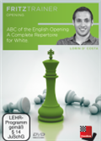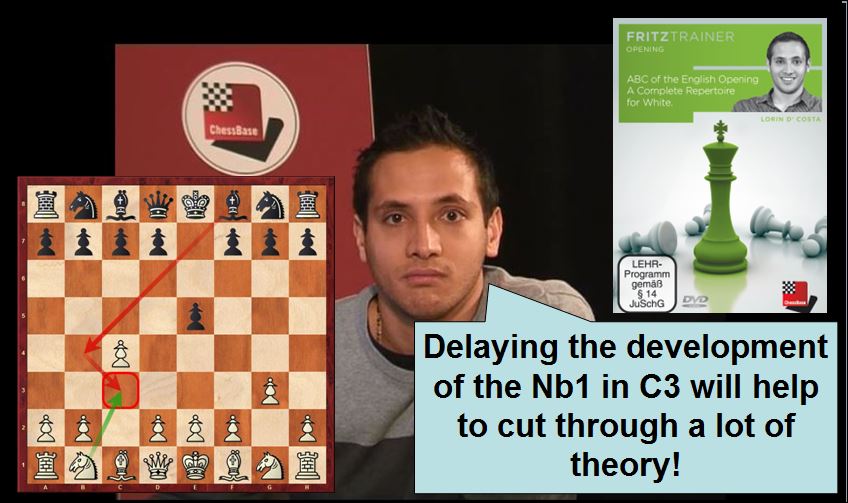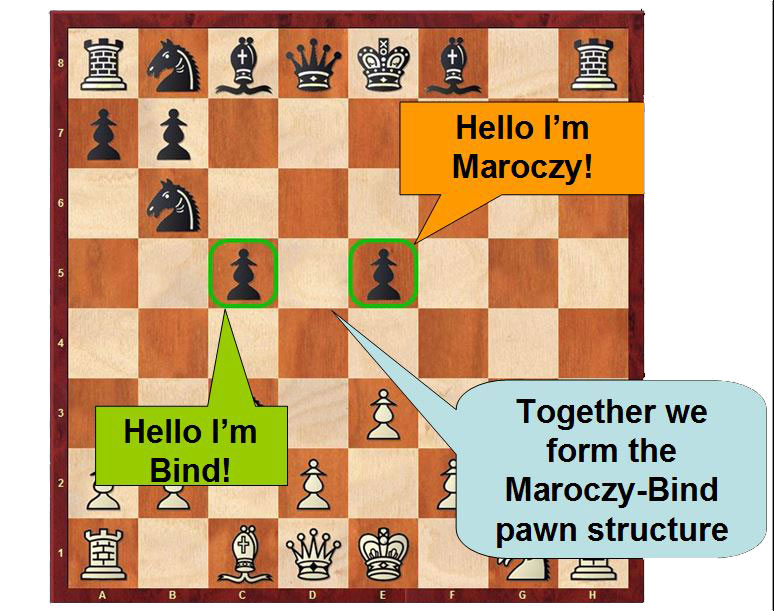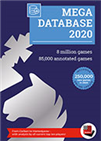A complete repertoire for White
The repertoire proposed by D'Costa is based on the moves: c4, g3, ♗g2, and ♘c3 with the move order determined by how Black reacts. Yes, the English is the kind of opening where there can be some tricky move orders indeed. In many lines D'Costa shows how to sac a pawn in order to gain a devastating initiative.
D'costa says he has added the English Opening to his opening repertoire in recent years, with success. In fact, one of the games I found played by D'Costa was against former FIDE World Champion Rustam Kasimdzhanov. He is rated more than 300 points higher than D'Costa, so a draw against such formidable opponent is commendable for this opening. But apart from that draw, I found some other games played by D'Costa which can be interesting and inspiring as well. Here's a sample to show the different pawn structures one can encounter when playing the English:
The FritzTrainer is divided into four main sections. The first is based on 1.c4 e5 with 14 videos. D'Costa begins saying it is important to delay the development of the queenside knight — ♘b1-c3 — because in this way one cuts through the sea of theory.
 Success in the English is based upon understanding the plans and ideas available within this interesting opening. The games in this DVD will provide with exactly that-the armoury to play the English Opening as white with confidence!
Success in the English is based upon understanding the plans and ideas available within this interesting opening. The games in this DVD will provide with exactly that-the armoury to play the English Opening as white with confidence!
He really enjoys showing some great games which help viewers remember the main ideas we should implement during a game.
A good reason to begin to play the English relates to how it can help you learn to play certain pawn structures of the Sicilian. For example after the moves, 1.c4 e5 2.g3 ♞f6 3.♗g2 d5 4.cxd5 ♞xd5 5.♘c3 ♞b6, Black could continue with c7-c5 which is a typical pawn structure adopted by White against the Sicilian — the so-called Maroczy bind:
As White, we could have the Maroczy bind after the moves: 1.e4 c5 2.♘f3 ♞c6 3.d4 cxd4 4.♘xd4 g6 followed by 5.c4:
 D'Costa treats at length the weaknesses and strengths of the lines he shows, which is all we should ask from a teacher. We don't want someone selling us an opening, like they would sell us a car. We want someone who evaluates the position at master level, and explains the good and bad points of the opening, to help us prepare for our tournament games.
D'Costa treats at length the weaknesses and strengths of the lines he shows, which is all we should ask from a teacher. We don't want someone selling us an opening, like they would sell us a car. We want someone who evaluates the position at master level, and explains the good and bad points of the opening, to help us prepare for our tournament games.
After explaining the theory and ideas generally, D'Costa pragmatically begins to examine an entire game. I'd like to show a sample of games with the following line: 1.c4 e5 2.g3 ♞c6 3.♗g2 ♞f6 4.♘c3 ♝b4 5.♘d5, because it can give you an idea of the variety of themes available in the English.
The second part of the FritzTrainer treats the symmetrical English: 1.c4 c5, with 7 videos.
In the beginning — maybe thanks to the passion and inspiration by the games shown by D'Costa — I threw myself into playing the English online, and most players there played 1.c4 e5 giving me a lot of satisfaction, and easy wins.
Then when I moved on to play the English OTB (Over The Board) at tournaments, strangely everyone was playing 1...c5 and I wasn't prepared as well, because I must admit I didn't study as much this second part!
But it was a great learning experience because it led me to re-evaluate the entire opening. I practically discovered that after 1.c4 e5 I easily entered semi-open or even open positions which were easy to play, and win. Instead, after 1.c4 c5 I entered closed positions, which were more difficult for me, because I was unprepared. The point is: with the English one can learn how to play open, semi-closed, and closed positions, making the English the opening to adopt and use if one is interested in developing as player.
The main line proposed by D'Costa is 1.c4 c5 2.g3 g6 3.♗g2 ♝g7 4.♘c3 ♞c6:
Here he begins to explain White's many possibilities and the ideas behind.
Just for the sake of clarity, D'Costa doesn't believe in the Botvinnik system which we have after the moves: 1.c4 c5 2.g3 g6 3.♗g2 ♝g7 4.♘c3 ♞c6 5.e4 to which D'Costa says Black can continue with the neutralizing: 5...e5 6.♘ge2 ♞ge7:
In D'Costa's opinion both sides have an outpost in d4/d5 and he finds it very difficult to win.
Instead, D'Costa recommends the setup with ♘f3, which we have after the moves: 1.c4 c5 2.g3 g6 3.♗g2 ♝g7 4.♘c3 ♞c6 5.♘f3:
Now Black has many choices, and D'Costa covers them all, giving us a repertoire which will neutralize most of our opponents' plans. I wrote "most" here because D'Costa can only do half the job, which is to convey the main ideas of the opening and how we should play. But then it is up to us to finish the preparation playing over the database of games provided with this FritzTrainer — 58 games to be precise.
Alternatively, use the latest MegaBase 2020, and find the latest games played with the lines given by D'Costa, to avoid bad surprises and to be aware of possible new ideas implemented by Black since this FritzTrainer's release.
 The ChessBase Mega Database 2020 is the premiere chess database with over eight million games from 1560 to 2019 in high quality. Packing more than 85,000 annotated games, Mega 2020 contains the world‘s largest collection of high-class analysed games. Train like a pro! Prepare for your opponents with ChessBase and the Mega Database 2020. Let grandmasters explain how to best handle your favorite variations, improve your repertoire and much more.
The ChessBase Mega Database 2020 is the premiere chess database with over eight million games from 1560 to 2019 in high quality. Packing more than 85,000 annotated games, Mega 2020 contains the world‘s largest collection of high-class analysed games. Train like a pro! Prepare for your opponents with ChessBase and the Mega Database 2020. Let grandmasters explain how to best handle your favorite variations, improve your repertoire and much more.Now don't discount the necessity to review many games. GM Mauricio Flores in his book about pawn structures acknowledges his study partner GM Bachmann's recommended training-study method: the need to play through a large number of games (obviously on the opening one wants to study, in this case the English) — just few minutes for each game — to gain knowledge of the repeating "patterns" which occur. For example, one of my problems was the weakness of the c4-pawn, so I paid attention when watching the games how White solved such a problem. Or when Black attacked the g2-bishop by placing a bishop on h3, I noted when it was correct to play Bh1 or when one should exchange, or do something else. However, while I put just five games for the line above, one should definitely watch many more if serious about the English.
On to the contents of the last two parts: the third treats the setups against the Slav, King's Indian Defence, and the Gruenfeld, with about twelve videos, and the fourth part is dedicated to 1.c4 b6 and other minor side lines.
The total running time of the DVD is around seven hours, giving serious student, the chance to get an understanding this repertoire within a week, just by listening to D'Costa for one hour a day.
Before finishing the FritzTrainer there is a chance to practice with eleven interactive videos, where D'Costa presents a position, and asks viewers to find the right continuation. To be honest D'Costa, as a good coach, also ask questions to the viewer in his normal videos like the following:

"How do you think White can proceed here? White has a lot of good squares on f6-g7, but how to make use of them?"
I paused the video, put the position on the board, and began to think what I would play.
D'Costa also doesn't waste time. He highlights the important critical moments of a game in the video, but in case the game is too long, or enters the endgame, D'Costa stops and suggests we study by ourselves, because the goal of the FritzTrainer is to give us a repertoire with the English which leads us to a playable middlegame, not to teach us the endgame conversion technique.
However, D'Costa also makes a good point when he says: "I suggest you try this variation out..." he gave us the way to play, then it is up to us to practice enough to be ready to use it in real games.
Find the right combination! ChessBase 15 program + new Mega Database 2020 with 8 million games and more than 80,000 master analyses. Plus ChessBase Magazine (DVD + magazine) and CB Premium membership for 1 year!
As mentioned before the DVD comes with a database of 58 selected games, a careful study of them is important. The latest ChessBase 15 has a training feature, which can be used to guess the move, and see how correct we are in finding the moves used by top players. Helping us to model our understanding of the English compared to them. While 58 games don't seem much, if one plays just one game a day with this training method, it can take up to two months.
I consider it extremely important to understand the fight for the centre in each opening. D'Costa shows it over and over in his videos treating the different lines, focusing our attention on the different types of struggles for the centre we can encounter in the English. But most of all teaching us the different manoeuvres our pieces should make, and the correct squares on which to position them.
D'Costa treats also another important aspect of the opening, how different pawn chains can pose a problem to the development of some of our pieces.

Final thoughts
I try to surprise my opponents, but I also try to see if playing the English will help me muster the courage to play the Sicilian one day. I believe the English could be the right key to teach me the structures and ideas which are also common in the Sicilian, like one might use the Dutch defence to learn how to play the Bird as White.
D'Costa does a good job synthesizing the knowledge needed to play this opening, thanks to a good selection of example games. These games will represent our mental library when we play the opening in tournaments, getting the right ideas and middlegame plans. The compact format of the FritzTrainer can be well-used as reference. When I began to practice the English in tournaments I discovered I forgot some lines. After each game I went back to see the video and discovered the way D'Costa treated the Symmetrical English was different from the way I played it, so sometimes one needs to watch the same videos a few times, at different intervals (so-called "spaced repetition"), in order to actually understand the material better.
Links
.jpeg)

















 D'Costa treats at length the weaknesses and strengths of the lines he shows, which is all we should ask from a teacher. We don't want someone selling us an opening, like they would sell us a car. We want someone who evaluates the position at master level, and explains the good and bad points of the opening, to help us prepare for our tournament games.
D'Costa treats at length the weaknesses and strengths of the lines he shows, which is all we should ask from a teacher. We don't want someone selling us an opening, like they would sell us a car. We want someone who evaluates the position at master level, and explains the good and bad points of the opening, to help us prepare for our tournament games.




